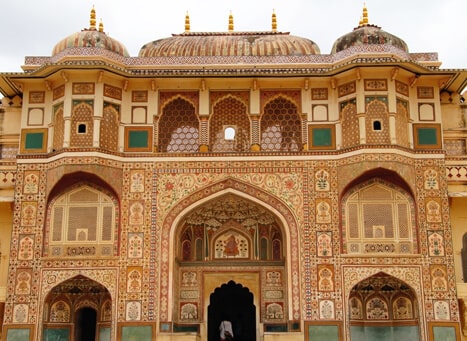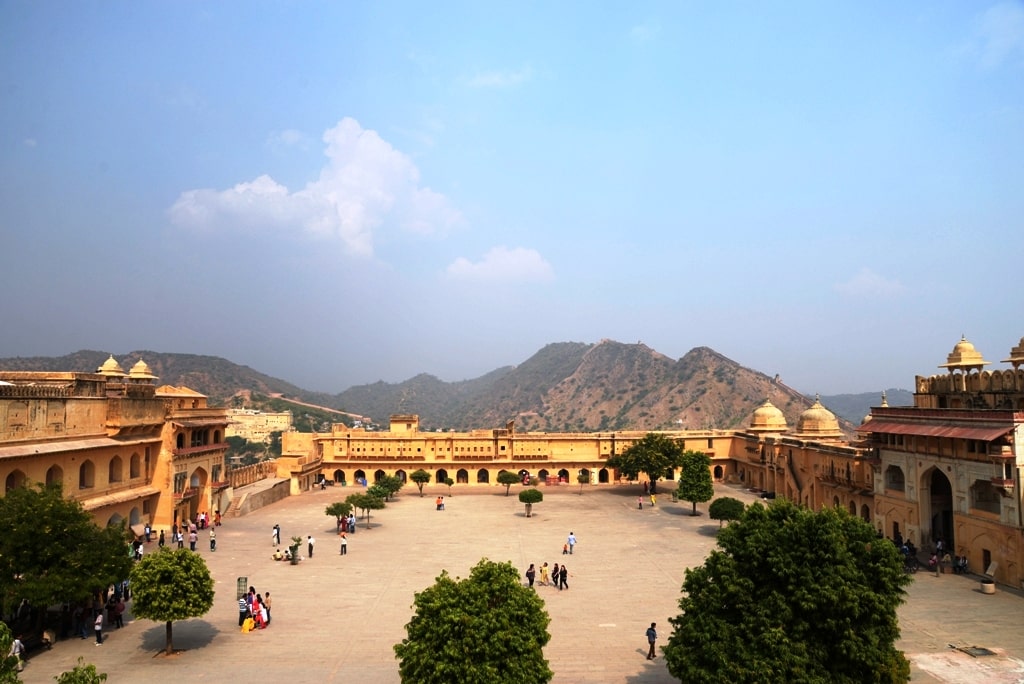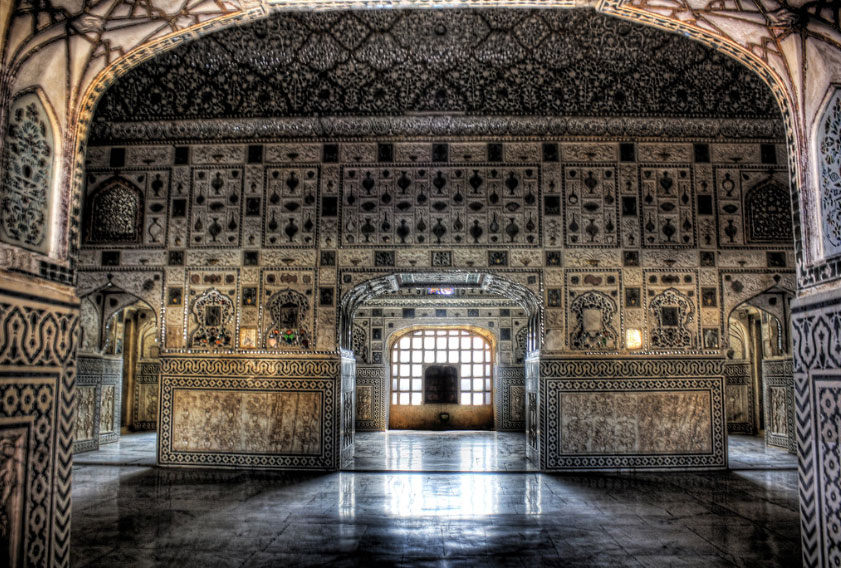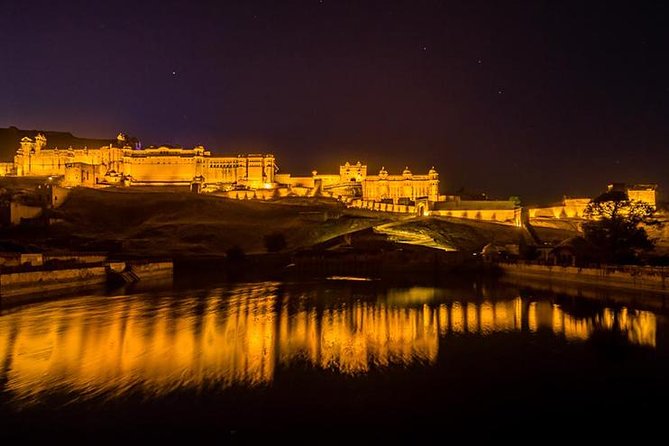
Cradled on the crest of a hill, overlooking the glistening Maota Lake, the majestic Amer Fort sprawls in all its glory; one of the most magnificent palaces in India. The Fort was built in the year 1592 by Maharaja Man Singh I, one of the most trusted generals of Akbar. The fort served as the main citadel of the Kachhawaha Rajput Rulers (warrior rulers of the historical region of Rajputana) until 1727. It is an extensive palace complex built with white marble, pale yellow and pink sandstone. In 2013, Amer Fort, together with 5 various other forts of Rajasthan, was declared a UNESCO World Heritage Site as part of the group- Hill Forts of Rajasthan.
Naming
Amer Fort is also referred to as Amber Fort. There are multiple etymologies provided so far for the naming of “Amber”. The stories include it being named after Ambikeshwar, the title of Lord Shiva. Whereas the Jain inscriptions of the 16th and 17th centuries talk about the derivation of the name from the name of Goddess Ambavati. Another tale claims that the name was derived from Amba, the universal mother. The city of Amer was known as Dhundar in medieval timelines under the Meenas.
History
The state of Jaipur, known as Dhundhar in the medieval period was controlled by Meena chiefs of five different tribes who were under the suzerainty of the Bargurjar Rajput Raja of Deoti. Later a Kachhwaha prince Dulha Rai destroyed the sovereignty of Meenas and also defeated Bargurjars of Deoti and took Dhundhar fully under Kachwaha rule.
The very first Rajput structure was begun by Raja Kakil Dev when Amber became his capital in 1036, on the site of the existing day Jaigarh Fort of Rajasthan. Most of the ancient structures of the Medieval period of the Meenas are non-existent now due to being destroyed or made over. Much of Amber’s existing buildings were initiated or developed during the power of Raja Man Singh I in the 1600s and most of them are still well maintained.
In 1592 AD Raja Man Singh built the Fort of Amer. The expansion and renovation efforts regarding the Amer Fort carried on for the next 150 years by his three successors. Modified and restructured many times during the timelapse, the Fort still stands tall against all the odds with the greatest of fervour.
The present Amer Fort was fully established in the late 16th century, as an alternative and in need of an ample palace to the already existing abode of the rulers, which was regarded as the Kadimi Mahal (Persian for ancient). It is known to be the oldest enduring palace in India and is situated in the valley behind the Amer Fort.
Geography
Amer Fort is situated 11 kilometres (6.8 mi) from Jaipur, the capital of Rajasthan. Located high up on a hill in the Aravalli ranges, consisting of a collection of gates and cobbled paths, the large ramparts of the fort overlook the enchanting Maota Lake. Located near the National Freeway 11C to Delhi, a narrow 4WD road leads up to the fort’s entrance gateway. The main entrance is through the imposing Suraj Pol (“sun gate”) unless you arrive by car, then one can enter via the Chand Pol. Both these gates open into the Jaleb Chowk, which is the main courtyard of the Amer Fort.
Architecture
Amer Fort is one of the finest examples of Rajput architecture, a combination of both Mughal and Hindu cultural styles. Built with white marble, pale yellow and pink sandstone, the fort flaunts a colourful architectural layout throughout the palace. There are many incredibly built structures and objects of artistic bliss, as well as lush green gardens within the fort.
The carvings on the walls and ceilings are a key attribute of the palace which consists of many vibrant and illustrative paintings of famous Rajput rulers, ancient hunting weapons, intricate floral patterns etc. There are several special chambers within Amer Fort, each serving a different purpose.
Mirror mosaics and coloured glasses of the Sheesh Mahal, Latticed screens on the windows of Diwan-e-Khas, and cool breeze flow through the Sukh Niwas and Ganesh Pol- a special entrance room where the Maharaja used to access palaces are some examples of fine architectural marvels on display within the Amer Fort.
The location of forts, palaces, temples, gardens etc are carefully envisioned within the fort, utilizing the positioning of lakes, ponds, rivers, and step-wells as a modus operandi for panoramic views, water and irrigation purposes and also as a defence mechanism. This itself is an example of the brilliance of architecture, power, knowledge, grandeur and the defence technology the Rajput rulers possessed.
A subterranean passage connects the Amer Fort to the Jaigarh Fort, located on Cheel Ka Teela on Aravalli hills, which are often regarded as a single structure.
Layout

Amer Fort is divided into four sections, each adorned with its separate entrance and courtyard.
First Courtyard (Main Courtyard)
Suraj Pol/Sun Gate:
The main entrance to the fort is an east-facing gate which has its name owing to its position concerning the rising sun.
Chand Pol/Moon Gate:
The Chand Pol, a gate directly opposite the Suraj Pol, leads to the old town outside the fort.

Jaleb Chowk:
Both these gates open into the Jaleb Chowk, an impressive main courtyard, where in earlier times, returning armies used to display their plunder to the people when women were only allowed to watch the proceedings through the windows.
Shila Devi Temple:
On the right of the Jaleb Chowk, this small temple has intricate marble carvings along with a double door entrance which is covered with silver. The idol, an incarnation of Kali or Durga placed inside the temple, was presented to Raja Man Singh by the ruler of Jessore, Bengal in 1604 after their defeat.
Second Courtyard (Audience Hall)

Diwan-i-Aam/Public Audience Hall:
A raised platform with 27 colonnades, with an elephant-shaped motif at the top of each pillar. A place where the rulers listened to and addressed the problems of the common people.
Diwan-e-Khas/Private Audience Hall:
A place restricted for official state policy matters only and concerns regarding taxes, revenue, security etc. were discussed here with a very select audience, restricted only to the ministers of the concerned subjects.
Third Courtyard(Residence of the Royal Family)
Ganesh Pol/Ganesh Gate:
It is a beautifully painted gateway to three private palaces built around an enclosed Mughal-style garden – Aaram Bagh.
Jai Mandir/Hall of Victory:
The marble Jai Mandir, at the other end of the garden, contains the superb Sheesh Mahal studded with mirrors.

Sheesh Mahal:
The flame of a single candle, reflected in the tiny mirrors embedded in this chamber, transforms it into a starlit sky.
Jas Mandir/Hall of Glory:
This hall of the private audience has latticed windows, a floral ceiling of elegant alabaster relief work and glass inlay. A marble screen here overlooks the Maota Lake and wafts in cool air.
Sukh Niwas:
Sukh Niwas has doors carved from fragrant sandalwood, and water cascades over marble chutes to cool the interior.

Lake and Gardens:
The lake, which provides water to the fort, is surrounded by two exquisite gardens. The Kesar Kyari Bagh, which has star-shaped flower beds once planted with saffron (kesar) flowers, while Dilaram Bagh, was built in 1568 as a resting place for Emperor Akbar on his way to Ajmer.
Fourth Courtyard

Baradari:
In the centre of the courtyard is a collonaded pavilion called the Baradari. The furthermost end of the fort, which was also its oldest section, was converted into the Zenana (“women’s quarters”) by Man Singh I to house his 12 wives and concubines.
Light and Sound Show

Explore the history and culture of Rajasthan in the evening with the Light and Sound Show held at Amer Fort in Jaipur.
Tourism
How To Reach:
One can reach the fort through auto-rickshaws or taxis available from all across the city. You can also board public buses to Amer town from Ajmeri Gate and MI Road, or drive up by yourself. The Amer Fort is atop a hill so you can either take a walk, a jeep ride or choose an elephant ride. It is now considered much more ethical for tourists to take jeep rides up the fort, instead of riding the elephants.
Timing:
The Amer Fort is open for visitation from 8 am – 5:30 pm during the day and 6.30 PM to 9.30 PM for night tourism.
Elephant rides are available from morning 9:30 am – 1:00 pm.
Light and Sound Show:
October to February -6:30 pm (English)/ 7:30 pm (Hindi)
March to April – 7:00 pm(English)/ 8:00 pm (Hindi)
May to September – 7:30 pm(English)/ 8:30 pm (Hindi)
Entrance Fee:
Foreigner – Rs 550 per person
Foreign Students – Rs 100 per person
Indians – Rs 50 per person
Indian Students – Rs 10 per person
Light & Sound Show Fees: English Rs. 295.00 per person & Hindi Rs. 295.00 per person.
Frequently Asked Questions
Q. What is Amer Fort famous for?
Amer Fort is a UNESCO world heritage site as declared in 2013. One of the most beautiful forts in India, the fort is known for its Rajputana architectural style with a touch of Mughal elements, also rich heritage and culture. Within Amer Fort, the Sheesh Mahal, Ganesh Pol and Jas Mandir are visions to behold.
Q. What is the colour of Amer Fort?
Amer Fort is an extensive palace complex built with white marble, pale yellow and pink sandstone.
Q. What is the best time to visit Amer Fort?
October to February is the best time to visit Amer Fort when the weather is cooler compared to the rest of the year. If you want to avoid crowds, I would suggest you visit early in the morning and avoid the afternoon time. About two hours are sufficient to visit Amer Fort.
Q. How old is Amer Fort?
Amer Fort was Built in 1592, this year in 2023 the fort will be 431 years old.

